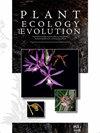克氏Eremitis clarkiae和香叶E.vinacea(Poceae,Bambusoideae):巴西巴伊亚州南部大西洋森林特有的两种新草本竹子,增加了该属在该热点地区的多样性
IF 1.1
4区 生物学
Q3 PLANT SCIENCES
引用次数: 3
摘要
背景和目的-本文描述了两个来自巴西巴伊亚的新种,并将它们与形态相似的种进行了比较。我们还提供了新物种的插图、照片、分布图以及栖息地和保护状况的注释。材料和方法:本研究基于野外考察、植物标本馆标本分析和文献综述。对野外采集的标本进行分析和拍照,并在温室栽培中进行观察。保护评估是基于实地观察和空间分析,遵循世界自然保护联盟的指导方针和标准。结果- 11月克拉氏埃米itis sp.发生在巴伊亚州南部,仅在弗洛雷斯塔Azul市收集过两次。该新种与巴伊亚特有的jardimii E.和robusta E.相似,但可以通过一些比这些物种中观察到的更长的营养和生殖结构来区分,例如叶状茎、叶状叶、平卧茎花序和雄蕊轮的雄蕊小穗的花梗。在巴伊亚州南部的三个地方收集到了葡萄球菌,但在最近的实地考察中,在Camacã市只发现了该型种群。它类似于E. afimbriata,一种Espírito Santo州特有的物种,通过其叶鞘与宿存的毛(vs无),叶片具有绿色的正面(vs蓝绿色带蓝色彩虹色),以及在平躺秆上的单个花序(vs多个)来区分。根据世界自然保护联盟的指导方针和标准,这两个新物种都是巴伊亚沿海森林分区域特有的物种,应该被视为极度濒危物种。本文章由计算机程序翻译,如有差异,请以英文原文为准。
Eremitis clarkiae and E. vinacea (Poaceae, Bambusoideae): two new species of herbaceous bamboos endemic to the Atlantic Forest of southern Bahia, Brazil increase the diversity of the genus in this hotspot
Background and aims – We here describe two new species of Eremitis from Bahia, Brazil, and compare them with morphologically similar species. We also provide illustrations, photos, a distribution map, and notes on habitat and conservation status of the new species.Material and methods – This study was based on fieldwork, analysis of herbarium specimens, and literature review. Specimens collected were analyzed and photographed during fieldwork and observed in cultivation in a greenhouse. The conservation assessment is based on field observations and spatial analyses, following the IUCN guidelines and criteria.Results – Eremitis clarkiae sp. nov. occurs in southern Bahia and has been collected only twice, in the municipality of Floresta Azul. The new species is similar to E. jardimii and E. robusta, both also endemic to Bahia, but can be distinguished by several vegetative and reproductive structures longer than those observed in these species, such as leafy culms, ligules, decumbent culm inflorescences, and pedicels of the staminate spikelets of the staminate whorls. Eremitis vinacea sp. nov. was collected in three localities in southern Bahia, but only the type population was found during recent field trips, in the municipality of Camacã. It is similar to E. afimbriata, a species endemic to Espírito Santo state, being differentiated by its leaf sheaths with persistent fimbriae (vs absent), leaf blades with green adaxial surface (vs bluish green with a blue iridescence), and a single inflorescence on decumbent culms (vs multiple). Both new species are endemic to the Bahian Coastal Forests subregion and should be considered Critically Endangered (CR), according to the IUCN guidelines and criteria.
求助全文
通过发布文献求助,成功后即可免费获取论文全文。
去求助
来源期刊

Plant Ecology and Evolution
PLANT SCIENCES-
CiteScore
2.20
自引率
9.10%
发文量
27
审稿时长
>12 weeks
期刊介绍:
Plant Ecology and Evolution is an international peer-reviewed journal devoted to ecology, phylogenetics and systematics of all ‘plant’ groups in the traditional sense (including algae, cyanobacteria, fungi, myxomycetes), also covering related fields.
The journal is published by Meise Botanic Garden and the Royal Botanical Society of Belgium.
 求助内容:
求助内容: 应助结果提醒方式:
应助结果提醒方式:


